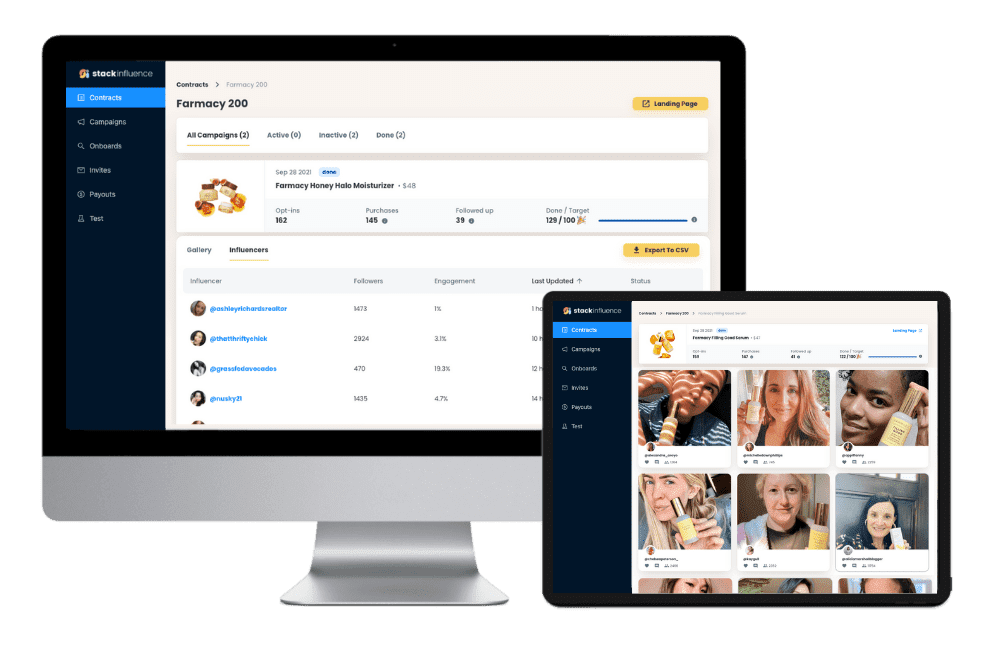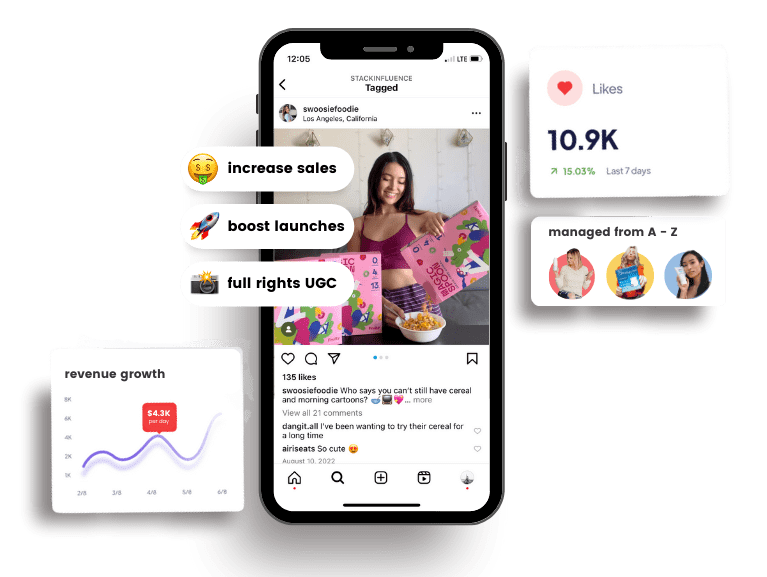Beauty Influencer Campaign Examples
17th
October, 2025
Influencer Marketing
Amazon Marketplace
Artificial Intelligence
TikTok Tips
Influencer marketing has become a game-changer for beauty brands. From cosmetic giants to indie startups, companies are partnering with content creators to reach consumers in authentic ways. Why? Because it works – 74% of Gen Z (and 66% of millennials) have purchased beauty products based on influencer posts. The beauty industry is booming (the cosmetics sector is projected to grow by $20+ billion in the next four years), and much of that growth is fueled by influencers on TikTok, Instagram, and YouTube. Consumers now scroll social media for makeup tips and product recommendations, often trusting real people over polished ads. In fact, even a casual video from a micro-influencer can send sales skyrocketing – one Amazon seller’s skincare product sold out in just three days after a 10K-follower beauty enthusiast posted an unboxing and review.
From global luxury labels to direct-to-consumer e-commerce brands and Amazon sellers, everyone is tapping into influencer marketing to build social proof and buzz. Below, we’ll explore several standout beauty influencer campaign examples – and the strategies that made them successful – to inspire your own marketing efforts.
1. Glossier
Glossier stands out as a $1.8+ billion beauty brand built largely on influencer-fueled buzz. From the beginning, Glossier championed “regular people” as brand ambassadors – an early adopter of Instagram influencer marketing back in 2014. According to CEO Emily Weiss, it’s these everyday micro-influencers and devoted fans who make Glossier so special. The company’s rep program invites any enthusiastic customer (even those with just a few thousand followers) to become an ambassador and share their authentic product experiences. Glossier rewards referrals and often reposts content from small creators on its official Instagram, right alongside posts by celebrity fans. In other words, a makeup artist with 2,000 followers might get a shout-out on Glossier’s feed just as readily as a post from Olivia Rodrigo. This inclusive, community-driven approach has created a massive network of advocates raving about Cloud Paint blushes and Boy Brow gels because they genuinely love them. By amplifying UGC and micro influencers, Glossier built intense customer loyalty and word-of-mouth – the kind of buzz you can’t buy with traditional ads.

Unlock the Power of Micro Influencers and Elevate your Brand Today!

2. Morphe
As the tagline goes, Morphe is truly “makeup for the creators.” This brand thrives on content created by its customers and fans, especially micro influencers. Morphe’s famous hashtag campaign #MorphBabe has generated over 3 million Instagram posts of user-generated looks, tutorials, and product photos. The company actively reposts these fan creations, effectively turning its social media feed into a showcase of real customers wearing Morphe. This always-on UGC strategy means Morphe never runs out of fresh content and constantly makes its community feel seen. The payoff has been huge – over a billion social interactions across Morphe’s channels, and a highly engaged fan base. With 10+ million Instagram followers now tuned in, Morphe’s content strategy proves that focusing on micro creators and customers can outshine any glossy ad campaign. By giving shout-outs to small creators (and a chance to be featured to millions), Morphe incentivizes more influencers to tag them, creating a virtuous cycle of organic promotion. It’s a masterclass in building a community-driven brand: empower your micro-influencer fans and they’ll effectively do the marketing for you.
3. NYX Cosmetics
NYX is often cited as a pioneer in micro-influencer marketing for beauty – and for good reason. Back in 2016, NYX ran an extensive product gifting campaign, sending free makeup to hundreds of up-and-coming YouTube and Instagram beauty gurus. This was long before “micro-influencer” was a buzzword, but NYX understood the power of seeding products with passionate content creators. The result? NYX saw a 97% jump in social engagement during that period. That grassroots buzz helped propel NYX (a then-20-year-old brand) to become one of the biggest makeup brands on social media. Fast forward to recent years, and NYX continues to spark conversations through creative UGC challenges. A standout example was the #ButterGlossPop campaign on TikTok: NYX invited beauty lovers of all follower sizes to showcase looks using its Butter Gloss lip gloss. The response was massive – the hashtag racked up 10 billion views and fans created over 2 million videos featuring the gloss. Many participants were regular consumers and micro influencers whose collective content made Butter Gloss go viral. The product literally flew off shelves (many shades sold out in stores during the campaign’s peak). By combining free product seeding, a catchy hashtag, and TikTok’s creator culture, NYX proved that micro influencers + UGC can ignite a viral moment and drive real e-commerce sales.
4. ColourPop
ColourPop built its brand in the digital era, relying on social media and influencer collaborations rather than traditional ads. Known for affordable, trendy cosmetics, ColourPop leveraged beauty influencers on Instagram and YouTube to rapidly grow a fan base. These collaborations introduced ColourPop to new waves of followers through tutorial videos and honest reviews. A hallmark of ColourPop’s strategy is featuring customers of all shapes and sizes on its platforms – you’ll see mega-influencers and everyday fans alike on their Instagram grid. In fact, like many beauty brands that work with micros, ColourPop heavily repurposes user-generated content across their social channels. When customers tag a look using ColourPop products, the brand often re-posts it, giving credit to the creator. This not only provides constant social content but also encourages more fans to post (for a chance to be featured). Additionally, ColourPop regularly sends PR packages of new product launches to influencers big and small, knowing that genuine excitement from a handful of micro creators can spark a trend. By embracing UGC and community over big-budget ads, ColourPop stays highly visible in social feeds and keeps its products organically trending among makeup lovers.
5. Frank Body
Australian skincare brand Frank Body offers a textbook example of using influencers to launch a product. Today they’re known for their coffee body scrub, but back in 2017 nobody had heard of it – so they turned to micro-influencers to build buzz from scratch. Before the scrub even officially launched, Frank Body sent free samples to many beauty micro-influencers on Instagram, with one simple ask: “If you like it, please share it.” The response was an explosion of posts about this mysterious coffee scrub, creating intrigue and demand even before the product was available. The end result was staggering – the campaign led to 2.2 million products sold (about $20 million in revenue) within just a few months of launch. Not bad for a brand with essentially zero traditional advertising! This early success was driven entirely by influencer word-of-mouth and UGC. Frank Body continues to feature creator content on Instagram and TikTok (the hashtag #frankbody has countless posts of users covered in coffee scrub). The lesson: giving out a few free products to micro-influencers who genuinely love them can trigger massive organic buzz. Influencers lent social proof to Frank Body’s launch, turning a unknown scrub into a cult favorite overnight.
6. Sephora
Even beauty industry heavyweights are embracing micro-influencer campaigns. Sephora, one of the world’s largest cosmetics retailers, might not need help getting the word out – yet it actively works with micro and mid-tier influencers to keep its brand relatable and tapped into trends. Sephora’s signature #SephoraSquad program invites influencers of all sizes and backgrounds to apply to be brand ambassadors, and each year a new “class” of Squad members is selected (many of them are micro-influencers). Those chosen get amazing perks: professional mentorship, invites to VIP beauty events, and loads of free products. In return, they agree to create honest content, reviews, and feedback for Sephora and the brands it carries. This program has yielded tons of user-generated content – from candid product reviews on Instagram to YouTube tutorials featuring Sephora products – not to mention invaluable insights for the company. More importantly, Sephora Squad has cultivated an army of passionate micro-influencer allies who feel a genuine connection to the retailer. By democratizing who gets to be an influencer for the brand, Sephora brings in fresh voices from all corners of the beauty community: everyone from small-town makeup artists to skincare enthusiasts. The Squad’s diversity and authenticity make Sephora’s marketing feel less like top-down advertising and more like advice from friends. It’s a prime example of a big brand leveraging micro creators to stay community-driven and authentic.
7. e.l.f. Cosmetics
e.l.f. (short for eyes lips face) went from an affordable drugstore brand to a social media phenomenon thanks to its bold influencer campaigns – especially on TikTok. In late 2019, e.l.f. launched the viral #EyesLipsFace challenge on TikTok, becoming one of the first brands to fully crack the platform. The campaign invited users to show off their makeup looks to an original song (“Eyes Lips Face”) created just for the challenge. It blew up beyond anyone’s expectations: #EyesLipsFace became the most viral campaign in TikTok U.S. history, inspiring around 5 million user-generated videos and over 7 billion views of the hashtag. Virtually overnight, e.l.f. became a household name with Gen Z. Even celebrities like Lizzo, Reese Witherspoon, and Ellen DeGeneres jumped in and made their own TikToks with the song – organically. Off the back of that success, e.l.f. doubled down with more TikTok initiatives (including a follow-up reality-show style campaign called #EyesLipsFamous). The brand’s bold moves on TikTok paid off in both culture and commerce: one survey found e.l.f. shot up from teens’ #8 favorite makeup brand to #2 within a year, and despite a challenging 2020 for retail, e.l.f. saw eight consecutive quarters of sales growth following its TikTok wins. The takeaway here is the power of platform-specific influencer campaigns – e.l.f. understood TikTok’s vibe (music, challenges, authenticity) and leveraged everyday creators to create a genuine cultural moment. That translated into massive brand love and measurable sales among young consumers.

Unlock the Power of Micro Influencers and Elevate your Brand Today!

Conclusion to Beauty Influencer Campaign Examples
In summary, influencer marketing – especially with micro-influencers and UGC content – has proven incredibly effective for beauty brands of all sizes. The common thread is authenticity: modern consumers want to see real people using and loving the products. Whether you’re an indie e-commerce skincare line or an Amazon seller launching the next makeup must-have, partnering with micro influencers, content creators, and genuine fans can amplify your brand reach and credibility in a way traditional ads simply can’t.

By William Gasner
CMO at Stack Influence
William Gasner is the CMO of Stack Influence, he's a 6X founder, a 7-Figure eCommerce seller, and has been featured in leading publications like Forbes, Business Insider, and Wired for his thoughts on the influencer marketing and eCommerce industries.
Want new articles before they get published? Subscribe to our Awesome Newsletter.
stack up your influence
turning creativity into currency
our headquarters
111 NE 1st St, Miami, FL 33132
our contact info
[email protected]
stack up your influence
turning creativity into currency
our headquarters
111 NE 1st St, 8th Floor
Miami, FL 33132


